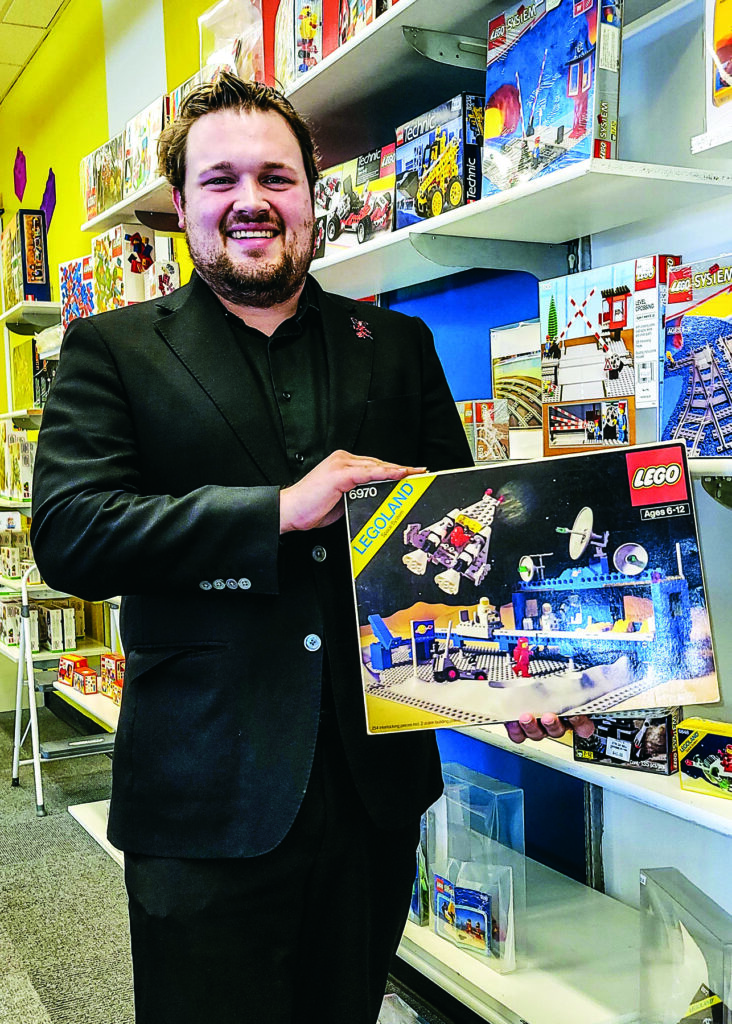moorhead business news

Zach Nienas has moved his popular Prairie Bricks Lego store to the EasTen Shopping Center. Among his collectible inventory is this vintage Beta 1 Command Base set from 1979. (Photo/Nancy Hanson.)
Zack Nienas has nurtured a passion for all things Lego, he says, “since before I had memories.” Ever since the day his mother brought home a big red bucket of the little plastic building blocks, he has been inspired by their possibilities.
“I went from playing with them to serious building and then figured out a way to make money off of it,” the 28-year-old entrepreneur confides. “They changed my world.”
Now Zack’s lifelong love of the Danish building toys is on full display in Moorhead’s EasTen Mall. His store moved from the Center Mall to Highway 10 three weeks ago, where it took over the former location of Drummer’s Journey. (Meanwhile, Michael Carbone’s thriving drum store moved into a much larger space a few doors down.)
Generations of American children – mostly boys, but with a growing contingent of girls – have grown up as Zack did, mesmerized by the possibilities of building everything from parrots and pirate ships to landmarks, spacecraft, superheroes and fierce dragons. Created in the workshop of a Danish carpenter 90 years ago, the bricks emerged in their present form in Europe in 1958. Four years later, they were introduced in the U.S.; today the worldwide Lego Group is valued at $14 billion.
The name “Lego,” now familiar around the world, was coined by founder Ole Kirk Christiansen out of the Danish words “leg godt” – “good play” in his native tongue.
Decades of TV ads made “Zack the Lego Maniac” a familiar figure among the younger set. Nienas, in fact, answers to two spellings of his fortuitous first name – both Zach, based on his christened name, and Zack with a K, the one that’s his email address.
Zack’s experience with selling the highly collectible Lego sets dates back 13 year years to his bedroom, where he first logged onto the internet. “I wanted to buy some Lego Adventurers sets that had been discontinued, and found that their prices had gone up a lot,” he says. “The Mummy’s Tomb had sold for $20 back in the day, but now you couldn’t find one in the original box for under $200.”
Opportunity called. His early attempts to sell some of his own extra sets online was a success. That led to participating in several shows at Fargo’s ComicCon, then ValleyCon and now PopExpo. The love of Lego creations is common among the crowd attracted to those pop culture gatherings, he observes: “They attract a crowd who’s attracted to anything that’s kind of nerdy.”
Based on the enthusiasm of AFOLs – Adult Fans of Lego – who visited his booths, he spread his wings a little wider. Prairie Bricks became a pop-up shop in the Center Mall for five weeks before Christmas 2020. “I wanted to dip my toe in the water. Did this town have any desire for a Lego store?” he asked himself.
It was a serious question; at that time, Zack himself had never set foot in a store that catered to Lego maniacs of every age. Answer: It did. Like the Twin Cities and spots in Florida, Texas and California, the Fargo-Moorhead area turned out to be well populated with Lego enthusiasts. That led to the full-time enterprise that took root and blossomed in downtown Moorhead for 13 months, leading up to its recent move.
Prairie Bricks’ success is not an anomaly. Close to 4,000 stores now exist nationwide, between online sales and brick-and-mortar retail. “There are seven in North Dakota, to my knowledge,” the Lego seller says. “I’m the largest.”
Zack likens his store to a Lego pawn shop. Some sets he buys from children who have outgrown them, like his four siblings who grew up and moved on to other hobbies. He acquires other sets from adult enthusiasts like himself. They probably were hooked by gift-wrapped sets under the Christmas tree, but today are drawn to the complexities of the craft. “They’re much more than toys,” the storekeeper explains. “Lego really pushes your motor skills, along with gears and math. Which teeth go in which gears? If you do it right, you have action.”
Besides assessing the offerings of walk-in sellers, Zack searches online for Lego classics, both popular and rare. Online trading and selling is big business among the 200,000 hard-core collectors who register their finds on the website Brickset, plus presumably the millions more whose collections are still private.
Ages vary. Kids tend to get into the building systems between ages 4 to 11. As they enter their teens, a majority go on to other things; theirs are often the “finds” that will populate Prairie Bricks’ shelves. Serious builders and collectors – the AFOLS – tend to be in their late 20s and 30s.
The traffic is steady at Prairie Bricks, open from 11 a.m. until 7 p.m. six days a week. When Zack unlocks the doors before lunch, those who walk in tend to be families with children in tow, either hoping to sell their outgrown toys or entranced by the 1,000-plus sets on the shelves. By late afternoon, though, the faces are different: That’s when the serious Lego maniacs come out to barter, buy and talk over the expert builds in which they are engaging.
And while the region has a substantial number of AFOLs, a good share of those who are walking into Zack’s new store past his towering Jeffrey the Giraffe – built of Legos, of course – sport more distant addresses. For Lego fans, it seems, no vacation is quite complete if they spot a Lego store but drive by without stopping.


